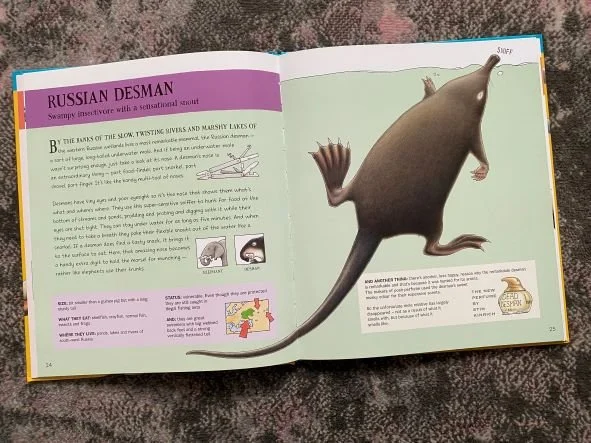
Reviews from Another Life
I have been reviewing books for many years. Here you can search for reviews of other titles by the authors, illustrators, poets and publishers featured on my ‘Reviews’ blog.
Lesser Spotted Animals
‘Lesser Spotted Animals’ speaks out for the overlooked, almost forgotten and practically unknown creatures of the animal world. Big or small, cute or quirky, endangered or numerous-the one thing that these animals have in common is that they are most definitely Z-list. Unlike the A-List celebrities of the natural world, these creatures have never had their moment in the lime light- that is, until now…
So, say goodbye to the gnu, cheerio to the cheetah and poo poo to the panda. There will be no lions and tigers and bears (oh my!) but rather pikas and numbats and yellow-footed rock wallabies. Prepare to meet the wonderfully wow wildlife you never normally get to see.
Each page of this book celebrates a different mammal, one of the thousands that never gets seen and never get talked about. Some of the animals within the book are plentiful. Take Africa’s pongy predator, the zorilla, for example. This carnivorous weasel-like creature may look a little like a skunk, but when it comes to pong-power, it knocks the more commonly known skunk out of the water. The zorillas’ potent stench can be smelt more than a mile away. Despite this, Kenyan farmers are eager to have zorillas around as they eat the grubs, rats and mice that ruin pastures and wreak havoc on their crops. There is also the dagger-toothed flower bat, the friendly fruit champion of the night. Although its name suggests otherwise, these are gentle creatures with a sweet-tooth. They flit from flower to flower sipping at the nectar. At the same time, they spread the pollen that has stuck to their faces, pollinating the trees. In fact, without these peaceful pollinators, some fruit trees would be entirely fruitless!
However, many of these Lesser Spotted Animals are far from numerous, with many being critically endangered or having so little known about them that it is impossible to say whether or not they are at risk. The rocky rabbit relative, the ili pika, was first discovered in 1983 and since then its numbers have halved, making it endangered. Unlike its rabbit cousins, the ili pika has small rounded ears and shorter legs; it also has a voice, making short eep, eep, eep noises. They are just as cute as their rabbit relations though and have some seriously clever survival skills to help cope the long, cold, snowy winters. The numbat – toothy termite-eater of the Australian west – can scoff as many as 20,000 termites each day, licking them up with its long, sticky tongue. There are only about 1000 of these unique creatures left in the wild and their numbers continue to drop. Unbelievably, there are more giant pandas in the world than there are numbats, but, unlike those big black-and-white celebrities, they get little to no attention.
‘Lesser Spotted Animals’ is an absolutely fascinating and eye-opening look at the natural world, delivering a powerful message, especially when sharing those animals that are endangered but whose plight (and existence) is virtually unknown to most of us. However, the book does not preach or lecture. In fact, its accessible chatty style, fact boxes and humour make it a light, easy read which would appeal to most children as it manages to be factual, engaging and funny all at once. The text is a perfect mix of scientific terminology and facts with description and anecdotes that will allow children to visualise the animals. For example, the size of each animal is described in ways such as, ‘as long as two average twelve year-olds, end-to-end,’ and, ‘about as big as a mouse – with wings.’ Alongside this are Martin Brown’s brilliant illustrations. Every page is full colour with delightful cartoon character animals, many of which have fun speech bubbles, which will have you chuckling to yourself. As well as the large illustrations, there are plentiful additional smaller pictures which will raise a smile: the sand cat in an ‘I heart sand’ t-shirt; the dagger-toothed flower bat dressed as batman; the tap-dancing black-footed ferret.
This gem of a book will hook children into learning more about lesser known animals. They can discover some of the 5,500 species of mammal out there in the world such as the dik dik, dingiso and delicate deer mouse (that just sneak on to the final page of the book). Perhaps, this could lead toward them creating their own book of ‘Lesser Spotted animals,’ (or a version about birds, marine life, insects, reptiles…). The small maps and geographical information on each page encourage a more detailed look at animal habitats and how different creatures survive in more extreme environments. This is also an excellent springboard for looking at classification and species diversity. Part of the detailed glossary is the different statuses used to classify animals, from least concern to extinct. Children could learn about the reasons behind why different creatures, through history to the present day, have become endangered and even extinct, as well as the different ways they are being protected. They could use persuasive writing and advertising to create their own campaign to help raise awareness about a ‘Lesser Spotted’ animal (just like the campaigns that have been used to rally support for the ‘celebrity’ pandas, elephants and koalas). Such work, with older children, would also help them to consider the part that media exposure contributes to fame – why have some of these animals become such celebrities of the natural world, and others not. Why do we care so much about them?
Lesser Spotted Animals – The Brilliant Beasts You Never Knew You Needed To Know About
Martin Brown
David Fickling Books ISBN: 978-1910200537
Martin has written a second book called ‘Even More Lesser Spotted Animals’, also published by David Fickling Books (ISBN: 978-1338349610). Some guided reading notes for the first book are available in Reading Resources.


